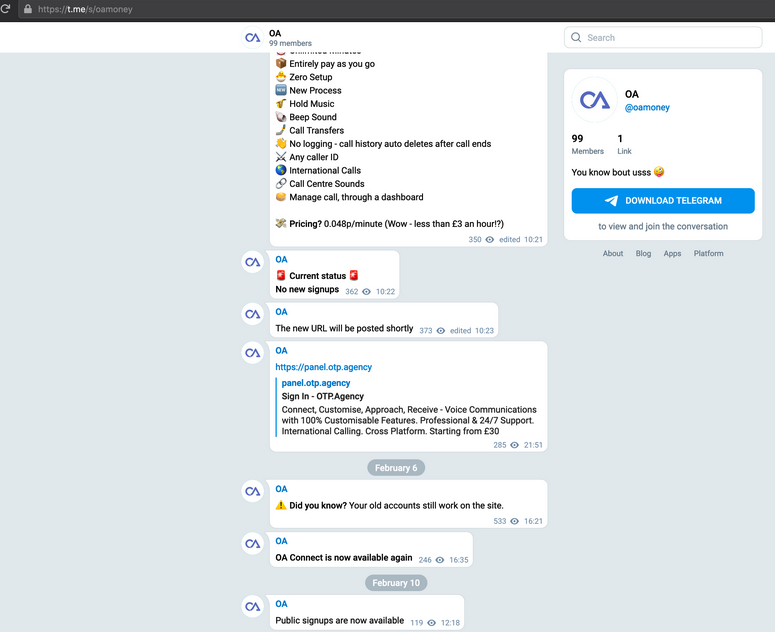Residents across the United States are being inundated with text messages purporting to come from toll road operators like E-ZPass, warning that recipients face fines if a delinquent toll fee remains unpaid. Researchers say the surge in SMS spam coincides with new features added to a popular commercial phishing kit sold in China that makes it simple to set up convincing lures spoofing toll road operators in multiple U.S. states.
Last week, the Massachusetts Department of Transportation (MassDOT) warned residents to be on the lookout for a new SMS phishing or “smishing” scam targeting users of EZDriveMA, MassDOT’s all electronic tolling program. Those who fall for the scam are asked to provide payment card data, and eventually will be asked to supply a one-time password sent via SMS or a mobile authentication app.
Reports of similar SMS phishing attacks against customers of other U.S. state-run toll facilities surfaced around the same time as the MassDOT alert. People in Florida reported receiving SMS phishing that spoofed Sunpass, Florida’s prepaid toll program.

This phishing module for spoofing MassDOT’s EZDrive toll system was offered on Jan. 10, 2025 by a China-based SMS phishing service called “Lighthouse.”
In Texas, residents said they received text messages about unpaid tolls with the North Texas Toll Authority. Similar reports came from readers in California, Colorado, Connecticut, Minnesota, and Washington. This is by no means a comprehensive list.

A new module from the Lighthouse SMS phishing kit released Jan. 14 targets customers of the North Texas Toll Authority (NTTA).
In each case, the emergence of these SMS phishing attacks coincided with the release of new phishing kit capabilities that closely mimic these toll operator websites as they appear on mobile devices. Notably, none of the phishing pages will even load unless the website detects that the visitor is coming from a mobile device.
Ford Merrill works in security research at SecAlliance, a CSIS Security Group company. Merrill said the volume of SMS phishing attacks spoofing toll road operators skyrocketed after the New Year, when at least one Chinese cybercriminal group known for selling sophisticated SMS phishing kits began offering new phishing pages designed to spoof toll operators in various U.S. states.
According to Merrill, multiple China-based cybercriminals are selling distinct SMS-based phishing kits that each have hundreds or thousands of customers. The ultimate goal of these kits, he said, is to phish enough information from victims that their payment cards can be added to mobile wallets and used to buy goods at physical stores, online, or to launder money through shell companies.

A component of the Chinese SMS phishing kit Lighthouse made to target customers of The Toll Roads, which refers to several state routes through Orange County, Calif.
Merrill said the different purveyors of these SMS phishing tools traditionally have impersonated shipping companies, customs authorities, and even governments with tax refund lures and visa or immigration renewal scams targeting people who may be living abroad or new to a country.
“What we’re seeing with these tolls scams is just a continuation of the Chinese smishing groups rotating from package redelivery schemes to toll road scams,” Merrill said. “Every one of us by now is sick and tired of receiving these package smishing attacks, so now it’s a new twist on an existing scam.”
In October 2023, KrebsOnSecurity wrote about a massive uptick in SMS phishing scams targeting U.S. Postal Service customers. That story revealed the surge was tied to innovations introduced by “Chenlun,” a mainland China-based proprietor of a popular phishing kit and service. At the time, Chenlun had just introduced new phishing pages made to impersonate postal services in the United States and at least a dozen other countries.
SMS phishing kits are hardly new, but Merrill said Chinese smishing groups recently have introduced innovations in deliverability, by more seamlessly integrating their spam messages with Apple’s iMessage technology, and with RCS, the equivalent “rich text” messaging capability built into Android devices.
“While traditional smishing kits relied heavily on SMS for delivery, nowadays the actors make heavy use of iMessage and RCS because telecom operators can’t filter them and they likely have a higher success rate with these delivery channels,” he said.
It remains unclear how the phishers have selected their targets, or from where their data may be sourced. A notice from MassDOT cautions that “the targeted phone numbers seem to be chosen at random and are not uniquely associated with an account or usage of toll roads.”
Indeed, one reader shared on Mastodon yesterday that they’d received one of these SMS phishing attacks spoofing a local toll operator, when they didn’t even own a vehicle.
Targeted or not, these phishing websites are dangerous because they are operated dynamically in real-time by criminals. If you receive one of these messages, just ignore it or delete it, but please do not visit the phishing site. The FBI asks that before you bin the missives, consider filing a complaint with the agency’s Internet Crime Complaint Center (IC3), including the phone number where the text originated, and the website listed within the text.
Three men in the United Kingdom have pleaded guilty to operating otp[.]agency, a once popular online service that helped attackers intercept the one-time passcodes (OTPs) that many websites require as a second authentication factor in addition to passwords.
Launched in November 2019, OTP Agency was a service for intercepting one-time passcodes needed to log in to various websites. Scammers who had already stolen someone’s bank account credentials could enter the target’s phone number and name, and the service would initiate an automated phone call to the target that warned them about unauthorized activity on their account.
The call would prompt the target to enter a one-time passcode that was sent to the user via SMS when the thieves attempted to log in. Any codes shared by the target were then relayed to the scammer’s user panel at the OTP Agency website.
A statement published Aug. 30 by the U.K.’s National Crime Agency (NCA) said three men pleaded guilty to running OTP Agency: Callum Picari, 22, from Hornchurch, Essex; Vijayasidhurshan Vijayanathan, 21, from Aylesbury, Buckinghamshire; and Aza Siddeeque, 19, from Milton Keynes, Buckinghamshire.
KrebsOnSecurity profiled OTP Agency in a February 2021 story about arrests tied to another phishing-related service based in the U.K. Someone claiming to represent OTP Agency then posted several comments on the piece, wherein they claimed the story was libelous and that they were a legitimate anti-fraud service. However, the service’s Telegram channel clearly showed its proprietors had built OTP Agency with one purpose in mind: To help their customers take over online accounts.
Within hours of that publication, OTP Agency shuttered its website and announced it was closing up shop and purging its user database. The NCA said the February 2021 story prompted a panicked message exchange between Picari and Vijayanathan:
Picari said: bro we are in big trouble… U will get me bagged… Bro delete the chat
Vijayanathan: Are you sure
Picari: So much evidence in there
Vijayanathan: Are you 100% sure
Picari: It’s so incriminating…Take a look and search ‘fraud’…Just think of all the evidence…that we cba to find…in the OTP chat…they will find
Vijayanathan: Exactly so if we just shut EVERYTHING down
Picari: They went to our first ever msg…We look incriminating…if we shut down…I say delete the chat…Our chat is Fraud 100%
Vijayanathan : Everyone with a brain will tell you stop it here and move on
Picari: Just because we close it doesn’t mean we didn’t do it…But deleting our chat…Will f*^k their investigations…There’s nothing fraudulent on the site
Despite deleting its Telegram channel, OTP Agency evidently found it difficult to walk away from its customers (and/or the money). Instead of shutting down as Vijayanathan wisely advised, just a few days later OTP Agency was communicating with customers on a new Telegram channel, offering a new login page and assuring existing customers that their usernames, passwords and balances would remain the same.

OTP Agency, immediately after their initial shutdown, telling customers their existing logins will still work.
But that revival would be short-lived. The NCA said the site was taken offline less than a month later when the trio were arrested. NCA investigators said more than 12,500 people were targeted by OTP Agency users during the 18 months the service was active.
Picari was the owner, developer and main beneficiary of the service, and his personal information and ownership of OTP Agency was revealed in February 2020 in a “dox” posted to the now-defunct English-language cybercrime forum Raidforums. The NCA said it began investigating the service in June 2020.

The OTP Agency operators who pleaded guilty to running the service; Aza Siddeeque, Callum Picari, and Vijayasidhurshan Vijayanathan.
OTP Agency might be gone, but several other similar OTP interception services are still in operation and accepting new customers, including a long-running service KrebsOnSecurity profiled in September 2021 called SMSRanger. More on SMSRanger in an upcoming post.
Text messages, emails and phone calls warning recipients about potential fraud are some of the most common scam lures. If someone (or something) calls saying they’re from your bank, or asks you to provide any personal or financial information, do not respond. Just hang up, full stop.
If the call has you worried about the security and integrity of your account, check the account status online, or call your financial institution — ideally using a phone number that came from the bank’s Web site or from the back of your payment card.
Further reading: When in Doubt, Hang Up, Look Up, and Call Back
PoC for an SMS-based shell. Send commands and receive responses over SMS from mobile broadband capable computers.
This tool came as an insipiration during a research on eSIM security implications led by Markus Vervier, presented at Offensivecon 2023
This is not a complete C2 but rather a simple Proof of Concept for executing commands remotely over SMS.
For the shell to work you need to devices capable of sending SMS. The victim's computer should be equiped with WWAN module with either a physical SIM or eSIM deployed.
On the operator's end, two tools are provided:
Of course, you could in theory use any online SMS provider on the operator's end via their API.
On the victim simply execute the client-agent.exe binary. If the agent is compiled as a Console Application you should see some verbose messages. If it's compiled as a Windows Application (best for real engagements), there will be no GUI.
The operator must specify the victim's phone number as a parameter:
server-console.exe +306912345678
Whereas if you use the python script you must additionally specify the MiFi details:
python3 server-console.py --mifi-ip 192.168.0.1 --mifi-username admin --mifi-password 12345678 --number +306912345678 -v
A demo as presented by Markus at Offensive is shown below. On the left is the operator's VM with a MiFi attached, whereas on the right window is client agent.
These are a collection of security and monitoring scripts you can use to monitor your Linux installation for security-related events or for an investigation. Each script works on its own and is independent of other scripts. The scripts can be set up to either print out their results, send them to you via mail, or using AlertR as notification channel.
The scripts are located in the directory scripts/. Each script contains a short summary in the header of the file with a description of what it is supposed to do, (if needed) dependencies that have to be installed and (if available) references to where the idea for this script stems from.
Each script has a configuration file in the scripts/config/ directory to configure it. If the configuration file was not found during the execution of the script, the script will fall back to default settings and print out the results. Hence, it is not necessary to provide a configuration file.
The scripts/lib/ directory contains code that is shared between different scripts.
Scripts using a monitor_ prefix hold a state and are only useful for monitoring purposes. A single usage of them for an investigation will only result in showing the current state the Linux system and not changes that might be relevant for the system's security. If you want to establish the current state of your system as benign for these scripts, you can provide the --init argument.
Take a look at the header of the script you want to execute. It contains a short description what this script is supposed to do and what requirements are needed (if any needed at all). If requirements are needed, install them before running the script.
The shared configuration file scripts/config/config.py contains settings that are used by all scripts. Furthermore, each script can be configured by using the corresponding configuration file in the scripts/config/ directory. If no configuration file was found, a default setting is used and the results are printed out.
Finally, you can run all configured scripts by executing start_search.py (which is located in the main directory) or by executing each script manually. A Python3 interpreter is needed to run the scripts.
If you want to use the scripts to monitor your Linux system constantly, you have to perform the following steps:
Set up a notification channel that is supported by the scripts (currently printing out, mail, or AlertR).
Configure the scripts that you want to run using the configuration files in the scripts/config/ directory.
Execute start_search.py with the --init argument to initialize the scripts with the monitor_ prefix and let them establish a state of your system. However, this assumes that your system is currently uncompromised. If you are unsure of this, you should verify its current state.
Set up a cron job as root user that executes start_search.py (e.g., 0 * * * * root /opt/LSMS/start_search.py to start the search hourly).
| Name | Script |
|---|---|
| Monitoring cron files | monitor_cron.py |
| Monitoring /etc/hosts file | monitor_hosts_file.py |
| Monitoring /etc/ld.so.preload file | monitor_ld_preload.py |
| Monitoring /etc/passwd file | monitor_passwd.py |
| Monitoring modules | monitor_modules.py |
| Monitoring SSH authorized_keys files | monitor_ssh_authorized_keys.py |
| Monitoring systemd unit files | monitor_systemd_units.py |
| Search executables in /dev/shm | search_dev_shm.py |
| Search fileless programs (memfd_create) | search_memfd_create.py |
| Search hidden ELF files | search_hidden_exe.py |
| Search immutable files | search_immutable_files.py |
| Search kernel thread impersonations | search_non_kthreads.py |
| Search processes that were started by a now disconnected SSH session | search_ssh_leftover_processes.py |
| Search running deleted programs | search_deleted_exe.py |
| Test script to check if alerting works | test_alert.py |
| Verify integrity of installed .deb packages | verify_deb_packages.py |





















